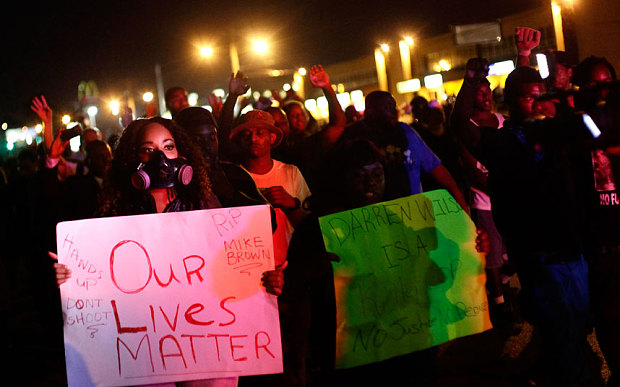Stuff Black People Don’t Like
October 16, 2014
A black mayor is an inevitability in Ferguson; the 67 percent black city today, that was 76 percent white in 1990 (99 percent white in 1970).
A black police chief and a majority black city council as well; after all, Ferguson is only 27 percent white and the city becomes ‘blacker’ as time marches forward.
But before this racial exchange of power occurs and the colonization of Ferguson by blacks into just another East St. Louis-style city is complete, whites are allowed a simple news story to air their grievances. [Weariness of Ferguson protests grows, St. Louis Post-Dispatch, 10-14-14]:
Brian Fletcher loves Ferguson. He brags about it, he rattles off historical facts about it and, as the former mayor, he feels the urge to stick up for the city and its people.
And right now, he says people are tired of the constant protesting, tired of the noise and tired of feeling intimidated.
That’s the exact reaction many protest leaders said they are hoping for.
It’s been nearly 70 days since Ferguson police Officer Darren Wilson fatally shot Michael Brown, 18.
Since then, protests have sprung up around the region, spreading most recently to downtown St. Louis, St. Louis University, Webster Groves and also the Shaw neighborhood, where crowds have gathered to protest the fatal shooting of teenager Vonderitt Myers Jr. by St. Louis police.
In one incident, video cameras captured a heated back-and-forth between protesters and Cardinals fans outside of Busch Stadium.
But the epicenter of the unrest is in Ferguson, and Fletcher, like many others, says it’s hard to remember what it felt like to live in Ferguson before the city became infamous.
On a typical day in Ferguson, there’s a persistent group of picketers along South Florissant Road, in front of the police station, holding signs with slogans such as: “Justice for All,” and “Black Lives Matter.”
Ferguson resident Jill Hatcher said she used to drive by and honk her car horn in support.
“Now I speed by with my windows up and my doors locked,” she said.
Hatcher’s fear stems from the events at night, when protesters sometimes march in the street drumming and chanting into the early hours.
Aside from the noise, there have been shots fired, attempted arson and some instances of looting.
Those are some of the reasons Fletcher started the “I Love Ferguson” group that is putting up yard signs, selling T-shirts and raising money.
So far, the group has raised more than $50,000, which Fletcher said would be donated to businesses affected by looting.
“People around here were sympathetic at first. People wanted to know why was he shot. And why so many times,” Fletcher said. “There wasn’t a problem until people started feeling scared to go to the brew house and scared to go to the farmers market.”
A QUESTION OF RACEFletcher, who is white, also acknowledges that persistent racial tension underlies Ferguson’s new reality.
“I think quite frankly, Caucasians are intimidated by protesters who think that if they can make Caucasians feel uncomfortable, they can change the rules. And it’s working,” Fletcher said.
A number of black people also feel uncomfortable. Pam Peters has lived in Ferguson for 37 years.
“I don’t like the way people are talking about Ferguson now,” she said. “We are good people. We are tired of the protests.”
Peters said she didn’t think Ferguson would ever go back to how it was before Brown’s shooting.
“We just have way too many young people who are trying to stir the pot,” she said. “If police stop them for no reason, that’s not right. But, not to beat a dead horse, some of them bring it on themselves.”
‘PLEASE END THIS’
Among people on both sides of the issue, many agree that a turning point came on the night of Sept. 23, when the Ferguson Fire Department responded to a small fire outside the Whistle Stop custard shop.
The century-old Whistle Stop building, a former train depot, is one of Ferguson’s historic landmarks. Law enforcement reported that someone had doused the outside of the building with gasoline.
Nearby, at Ferguson Optical, manager Tim Marrah said he was surprised about the racial tone the protests have taken. He said one of Ferguson’s charms was that it had always been a place where different races mixed.
Of the protesters, Marrah said he didn’t see a need for them to leave but rather to weed out the troublemakers.
“The protests don’t need to go anywhere,” he said. “This thing needs to be resolved. The violence and the property damage is the problem, not the protests.”
Down the street, at Natalie’s Cakes & More, owner Natalie Dubose said she supported people’s right to protest, while acknowledging that the same unrest had essentially dried up the foot traffic that she relies on along South Florissant.
Business really took a dive when the farmers market down the street shut for the season earlier than usual because of the protests.
At one point, Dubose said, she went two weeks without a single customer.
“I think it’s the perception that Ferguson now has,” she said. “People who would normally come through here now think it’s unsafe. It’s going to be very difficult to get out from under that.”
No, it’s going to be impossible to get out from under that, Mrs. Dubose. Get use to having no customers at your Natalie’s Cakes & More store as the city’s white population declines, unless you plan on accepting EBT/Food Stamps for your tasty treats.
 Daily Stormer The Most Censored Publication in History
Daily Stormer The Most Censored Publication in History



